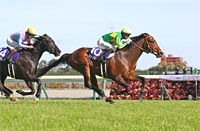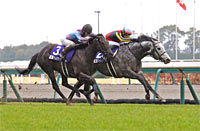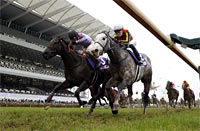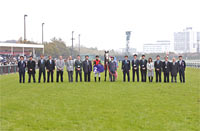Takamatsunomiya Kinen (G1) - Data Analysis
Race that decides spring sprint champion
In line with its reputation as a race that decides the spring sprint champion, the Takamatsunomiya Kinen has been won by a long line of famous and charismatic horses such as Kinshasa no Kiseki, Curren Chan, Lord Kanaloa, and Fine Needle. In the last 10 years, runners backed as 10th favorite or lower have achieved zero Top 2 finishes. In the last three years, five of the six Top 2 finishers were among the Top 3 favorites, while the remaining one was backed as 5th favorite. Let’s now identify some trends in this race based on results over the last 10 years, including the 2011 race held at the Hanshin Racecourse.
Last three winners contested the Silk Road Stakes in previous race
Looking at performances by runners over the last 10 years in terms of their previous race, we observe that runners that had entered the “Hankyu Hai,” the Yukan Fuji Sho “Ocean Stakes,” or the “Silk Road Stakes” each produced three winners. Runners that had contested the “Silk Road Stakes” achieved the highest success ratios, and delivered the three consecutive winners from 2016. Among runners that had contested an “Overseas race” last time out, Hong Kong-trained Aerovelocity triumphed in 2015, and among Japanese horses returned from abroad, the highest finish was third place (Red Falx in 2017). [Table 1]
[Table 1] Performance by previous race (last 10 years)
| Previous race |
Performance
[1st-2nd-3rd-4th or lower] |
Win
ratio |
Top 2 ratio |
Top 3 ratio |
| Hankyu Hai |
3-4-2-40 |
6.1% |
14.3% |
18.4% |
| Ocean Stakes |
3-2-4-60 |
4.3% |
7.2% |
13.0% |
| Silk Road Stakes |
3-1-3-18 |
12.0% |
16.0% |
28.0% |
| Overseas race |
1-0-1-4 |
16.7% |
16.7% |
33.3% |
| February Stakes |
0-1-0-4 |
0% |
20.0% |
20.0% |
| Kyoto Himba Stakes |
0-1-0-3 |
0% |
25.0% |
25.0% |
| Sprinters Stakes |
0-1-0-1 |
0% |
50.0% |
50.0% |
| Other race |
0-0-0-17 |
0% |
0% |
0% |
Focus on runners that achieved Top 2 finish in recent race
Looking at performances by runners over the last 10 years in terms of the number of Top 2 finishes within their last three outings, we find that runners with “3” Top 2 finishes achieved a Top 3 ratio of 46.7%. Conversely, of the 64 runners with “0” Top 2 finishes,” only Let’s Go Donki achieved a Top 3 finish (runner-up) in 2018. In other words, it would seem wise to focus on runners that have achieved a Top 2 finish in a recent race. [Table 2]
[Table 2] Performance by number of Top 2 finishes within last three outings (last 10 years)
Number of
Top 2 finishes |
Performance
[1st-2nd-3rd-4th or lower] |
Win
ratio |
Top 2 ratio |
Top 3 ratio |
| 3 |
3-2-2-8 |
20.0% |
33.3% |
46.7% |
| 2 |
3-1-3-21 |
10.7% |
14.3% |
25.0% |
| 1 |
4-6-5-55 |
5.7% |
14.3% |
21.4% |
| 0 |
0-1-0-63 |
0% |
1.6% |
1.6% |
Horses aged 4 to 6 have been strong performers in recent years
Looking at performances by runners over the last 10 years in terms of age, we note that horses aged 4 to 6 accounted for 17 of the 20 Top 2 finishers. Horses aged 7 and above achieved three wins: Kinshasa no Kiseki in 2010 and 2011, and Aerovelocity in 2015. In the three years from 2016, all Top 3 finishers were horses aged 6 or below (two 4-year-olds, five 5-year-olds, and two 6-year-olds). That said, 6-year-olds have not produced a winner over the last 10 years, which is an interesting statistic. [Table 3]
[Table 3] Performance by age (last 10 years)
| Age |
Performance
[1st-2nd-3rd-4th or lower] |
Win
ratio |
Top 2 ratio |
Top 3 ratio |
| 4 |
2-0-4-30 |
5.6% |
5.6% |
16.7% |
| 5 |
5-4-3-33 |
11.1% |
20.0% |
26.7% |
| 6 |
0-6-1-36 |
0% |
14.0% |
16.3% |
| 7 |
2-0-2-26 |
6.7% |
6.7% |
13.3% |
| 8 and above |
1-0-0-22 |
4.3% |
4.3% |
4.3% |
Watch runners that recently contested a 1,400m+ race
Looking at performances by runners over the last 10 year in terms of the number of 1,400m+ races contested within their last two outings, we observe that runners that had contested “2” or “1” such races achieved the higher Top 2 ratio. Of the 96 runners that had contested “2” or “1” 1,400m+ races within their last two outings, 14 finished in the Top 2. In contrast, of the 81 runners that contested “0” 1,400m+ races within their last two outings, six finished in the Top 2. Although the combined number of runners that contested “2” or “1” 1,400m+ races in their last two outings was only about 20% higher than the number of runners that contested “0” such races, the former group achieved more than double the Top 2 finishes of the latter group. We should therefore check whether runners have recently appeared in 1,400m+ races. [Table 4]
[Table 4] Performance by number of 1,400m+ races contested within last two outings (last 10 years)
| Number of races |
Performance
[1st-2nd-3rd-4th or lower] |
Win
ratio |
Top 2 ratio |
Top 3 ratio |
| 2 |
2-4-2-33 |
4.9% |
14.6% |
19.5% |
| 1 |
4-4-2-45 |
7.3% |
14.5% |
18.2% |
| 0 |
4-2-6-69 |
4.9% |
7.4% |
14.8% |
Seek out the winner!
Discount runners that suffered more than 1 major defeat in last four outings
The last nine winners of the Takamatsunomiya Kinen had been beaten to 6th or lower only once or zero times in their last four outings. This was also true for Aerovelocity, the Hong Kong-trained horse that triumphed in 2015. Accordingly, we should check whether a horse with few major defeats in recent races wins again this year. [Table 5]
[Table 5] Winners’ finishes in last four races (last 9 years)
| Year |
Winner |
4 races back |
3 races back |
2 races back |
Previous race |
| 2010 |
Kinshasa no Kiseki |
12th |
1st |
1st |
1st |
| 2011 |
Kinshasa no Kiseki |
2nd |
13th |
1st |
2nd |
| 2012 |
Curren Chan |
1st |
1st |
5th |
4th |
| 2013 |
Lord Kanaloa |
2nd |
1st |
1st |
1st |
| 2014 |
Copano Richard |
1st |
4th |
10th |
1st |
| 2015 |
Aerovelocity |
1st |
14th |
1st |
2nd |
| 2016 |
Big Arthur |
1st |
2nd |
3rd |
5th |
| 2017 |
Seiun Kosei |
13th |
1st |
1st |
2nd |
| 2018 |
Fine Needle |
5th |
1st |
12th |
1st |
(Michio Kawano)
|




















